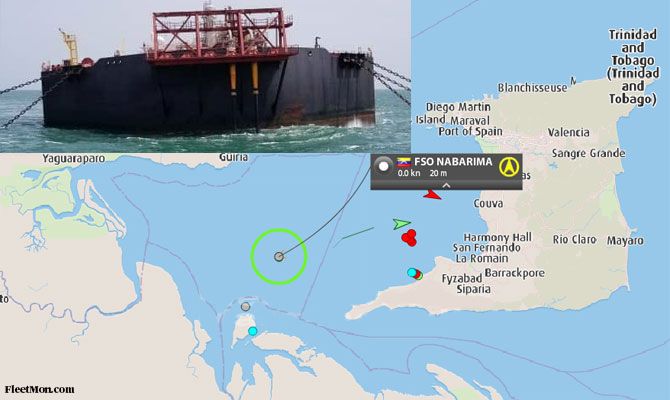(Trinidad Guardian) The large oil cargo on a damaged Venezuelan tanker in the Gulf of Paria, miles off Cedros will be transferred to a contracted vessel, but local groups want to know exactly when.
The Ministry of Foreign Affairs and the Energy Ministry yesterday gave an assurance on the situation after a bulletin from the Maritime and Crimean Shipping News (M&CSN) reported on Monday the storage vessel is leaning to the right after leaking and taking in water.
Guardian Media posed queries to both Ministries yesterday after the bulletin.
Watchdog group, Fishermen and Friends of the Sea (FFOS), also last week called twice for Government to pay attention to the situation. But FFOS didn’t receive a reply and finally appealed to the US Ambassador to assist.
The Venezuelan Ecology Society which is monitoring the leaking vessel recently warned that if it sinks it could trigger the “worst marine environmental disaster in that country’s history and potentially affect fisheries and coastlines in T&T.”
The tanker, “FSO NABARIMA”, which holds 173,000 tonnes of oil has been located in the Corocoro Field since 2015. It’s midway in the Gulf of Paria between T&T and the mainland. It has 1.3 million barrels of oil aboard.
The M&CSN bulletin stated it is operated by PDVSA, Venezuela’s state-owned oil company. It’s part of a joint venture with PetroSucre that runs the field. PetroSucre was producing and exporting about 11,000 daily barrels of crude oil to PDVSA’s US refining subsidiary Citgo until the US imposed oil sanctions on Venezuela in January 2019.
Eudis Girot (Unitary Federation of Petroleum Workers), a Venezuelan oil industry trade union leader told M&CSN the unit is in an emergency situation due to lack of proper and professional maintenance.
It was reported suffering water ingress (infiltration) in its engine room with some compartments up to 1.5 metres high, developing a starboard list and leaking.
Girot said there was nine feet of water in its lower decks. He displayed photos of water in the vessel.
Measurements taken yesterday showed water levels continuing to rise despite PDVSA’s efforts to pump it out to patch leaks, according to PetroSucre workers.
They said the engine room is so flooded there’s no possibility the unit can navigate under its own power to a terminal to discharge the oil.
Contacted yesterday morning – when Guardian Media also emailed the Energy Ministry – Foreign Affairs Minister Dr Amery Browne said via text, “Yes, we are monitoring the situation very closely.”
“The NABARIMA is an FSO (Floating Storage Offloading unit) that has been in that location for over a decade. It stores oil from the Corocoro Oilfield in the Venezuelan Gulf. The oil is then transferred to tankers for shipment abroad. However, because of (US) sanctions, the transfer vessels stopped operating.”
“The FSO is now at full capacity. Information coming out of Venezuela is that the ship is upright and in stable condition pending preparation for the transfer of the cargo to a contracted vessel.”
“The Energy Ministry is monitoring the situation closely. There is currently a bilateral oil spill contingency plan between Venezuela and T&T that will govern our response to any eventuality. Parties are free to request assistance from each other.”
The Energy Ministry responded in the afternoon issuing the same statement as Foreign Affairs.
The Energy Ministry didn’t state when the transfer of the oil cargo would occur but Ministry officials said focus will be on the issue since they acknowledged the “Nabarima’s” location in waters between T&T and the mainland.
Give the specifics —Ramdial, Aboud
The FFOS and other sectors had feared potential environmental calamity was brewing as a result of the situation, especially since in the last two months, damaged heat exchangers at PDVSA’s El Palito refinery spilt 25,000 barrels of oil into Venezuela’s Triste Gulf, polluting fisheries and mangroves.
FFOS secretary Gary Aboud said, “In recent newspaper articles the Minister said he had no knowledge of the vessel and later said the vessel was stable. But pictures show the vessel’s tilting. The issue is of particular concern since GPS location shows the vessel is maybe about four miles from Cedros.”
“We’d hoped a joint inspection could have been done of the vessel and any immediate danger to both nations assessed. However, Government’s statement (yesterday) was still third-hand information for T&T when in a matter of such public importance citizens need details. They must be proactive and say how it’s being dealt with.”
UNC MPs David Lee, Dev Tancoo, Ravi Ratiram whose constituents include fishermen, didn’t answer calls on the issue. Former Couva North MP Ramona Ramdial who had championed fishermen’s issues in her tenure, demanded specifics of Government.
“The seriousness of this situation and potential threat to all of T&T’s marine life and people’s livelihoods demand that Government must state specifics. It’s remained silent until this became an international issue,”
“When exactly will the oil be transferred to another vessel? Does Venezuela have capacity to do it if this deterioration was allowed to happen in the first place? Can T&T stand by to ensure the transfer doesn’t affect the Gulf? Tell the people!”






